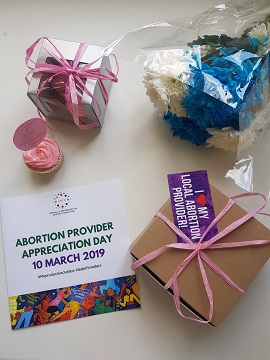
March 10 is Abortion Provider Appreciation day, a day that began in 1996 in memory of Dr David Gunn, the first abortion provider to be murdered (on that day in 1993) in the United States. It is a day to honour every provider who dedicates his or her life to help women and make reproductive choice possible. Without abortion providers, there is no access to abortion and no “choice” (Stevens, 9 March 2012)
Two CSSR members represented the Sexual and Reproductive Justice Coalition (SRJC) by giving abortion providers small tokens of appreciation i.e. pink cupcakes and cards. We visited one private abortion clinic and two public abortion clinics within Buffalo City. We have highlighted some of our experiences at these clinics below.
At the private clinic we were met with a notice on the wall outside that read:
On the walls inside the clinic reception area were posters explaining different kinds of contraception, there was a bowl of free condoms on the coffee table and there were pamphlets that you could take home and read. Once we had explained why we were there we were met with smiles, hugs and clear thankfulness that they appreciated that we appreciated them. We asked for a photo and there was no hesitation to take some, we even video called with the regional manager, who was in Kwa-Zulu Natal, who thanked us for stopping by and blew kisses through the phone.
At one of the public hospitals in Buffalo City we found it interesting that the abortion clinic was in the same area that’s known to the general public as the ‘maternity section’. We entered the ‘maternity building’ and searched for someone to provide us with some direction, as there were no signs to assist us along the way. Someone guided us downstairs around a few corners and into a room. There were a few posters on the wall, of which I made particular notice of- an illustration of contraception’s with actual examples glued onto the poster, it was situated in one of the corners in the room above eye level, a Breath of Life poster (Breath of life is a local public benefit organisation that supports women dealing with crisis pregnancies and refuge for abandoned babies) and a medically illustrated photo of a women receiving an abortion- which was situated above one of the nurses desks- it showed an apparatus used in the termination of pregnancy procedure and labels of different aspects of the procedure. We informed them of why we were there and thanked them for the difficult work that they do, they were grateful for the recognition. We asked for a photo but we could tell that they were uncomfortable with that.
At the next public hospital in Buffalo City we were instantly met with signs to guide us along. We followed the gynecological sign as it seemed most relevant to the signage available to us. After that we saw no more signs that could guide us to either a maternity or an abortion space. We had to ask for directions twice. At the maternity section, we asked for directions again, we explained why we were there and the midwife asked when she will get a day to be appreciated, after which she gave us directions to the CTOP department- around the corner and up the stairs. A security guard assisted us to the CTOP rooms. The only sign we saw along the way was the CTOP sign followed by handwritten “+ family planning” on the doors that entered the area.
The posters on the walls explained the women’s health clinic vision; there was also a Breath of Life poster. We met with the supervisor of the clinic who gave us a hug and asked questions about the SRJC, we informed her that as researches we know the kind of work that these health care providers do and would like to show our appreciation.
There was a definite difference in reception to our appreciation within all three sites. Once we had explained our intentions the providers welcomed us. Yet at the private clinic the responses were a lot more cheerful than at the public clinics.
We never got a chance to ask questions about the no male sign at the private clinic, but it definitely sparked some interest: have men been abrupt in that space, is it to protect women who go to the clinic, how do men in relationships with women support women when they go to the clinic and is it taken for granted that if a woman is going for an abortion she does not have support from the man. It was also interesting that within the public hospitals the abortion clinics were hidden away, down or upstairs, around corners and there was no clear signage, we had to ask numerous people about the location of the abortion clinics.
